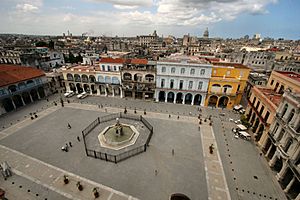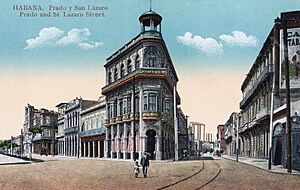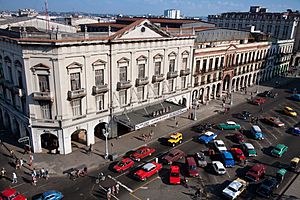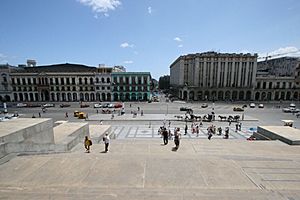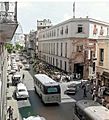Old Havana facts for kids
Quick facts for kids
La Habana Vieja
|
|
|---|---|
| Subdivisión de La Habana Vieja | |

Location of Old Havana in Havana
|
|
| Country | |
| Province | |
| Founded | November 16, 1519 |
| Belén, Catedral, Jesús María, Plaza Vieja, Prado, San Isidro, Tallapiedra | |
| Area | |
| • Total | 4 km2 (2 sq mi) |
| Elevation | 50 m (160 ft) |
| Population
(2022)
|
|
| • Total | 79,845 |
| • Density | 20,000/km2 (52,000/sq mi) |
| Time zone | UTC-5 (EST) |
| Area code(s) | +53-7 |
| Official name: Old Havana and its Fortification System | |
| Type: | Cultural |
| Criteria: | iv, v |
| Designated: | 1982 (6th session) |
| Reference #: | 204 |
| Contracting state: | Cuba |
Old Havana (Spanish: La Habana Vieja) is the historic heart of Havana, Cuba. It's one of the 15 main areas, or boroughs, that make up the city. This area is very old and was once surrounded by city walls. Today, these old wall lines mark the boundaries of Old Havana.
In 1982, UNESCO named Old Havana a World Heritage Site. This means it's a very special place that needs to be protected. It's famous for its beautiful old buildings, especially those built in the Baroque and neoclassical architecture styles. Its strong forts and important history as a stop for ships traveling to the New World also make it unique. A year later, a big effort began to fix up and restore its historic buildings.
Contents
History of Old Havana
Havana was started by the Spanish on November 16, 1519. It was built around the natural Bay of Havana. Soon, it became a key stop for Spanish ships carrying treasures between the New World and the Old World (Europe). By the 1600s, it was a major center for building ships.
The city's buildings were made in the fancy Baroque and Neoclassical styles. Many of these buildings became run-down in the late 1900s. But now, many are being fixed up. Old Havana has narrow streets filled with many old buildings. It's the oldest part of the city, with the port, the main government center, and the Plaza de Armas.
Pirate Attack and Forts
In 1555, a French pirate named Jacques de Sores attacked and destroyed Old Havana. He easily defeated the few defenders, stole what he could, and burned much of the city. But he didn't find the huge treasures he hoped for.
After this attack, the Spanish sent soldiers to Havana. They started building strong forts and walls to protect the city. The first fort, Castillo de la Real Fuerza, began construction in 1558. An engineer named Bartolomé Sanchez oversaw its building.
Old Havana looks a lot like other old Spanish cities, like Cádiz and Tenerife. A famous writer, Alejo Carpentier, called it "the city of columns." It's known for its many old buildings, forts, churches, palaces, and busy streets. The Cuban government has worked hard to save and restore Old Havana. This effort has turned it into a popular place for tourists.
Top Places to See
Old Havana is full of amazing places to visit. Here are some of the most famous:
- The Malecón is a famous road that runs along the ocean. It's a great place to walk and enjoy the sea breeze.
- The Paseo del Prado, Havana is a beautiful street that forms the western edge of Old Havana. It's a lovely place for a stroll.
- Castillo del Morro is a cool fortress that guards the entrance to Havana Bay. It was built after the English pirate Sir Francis Drake visited.
- La Cabaña fortress is on the other side of Havana Bay. It has huge 18th-century walls. Every night at 9 p.m., soldiers in old uniforms fire a cannon. This "gunshot of the nine" used to signal the closing of the city gates.
- San Salvador de la Punta Fortress is across from El Morro Castle. It was built in 1590. In the past, a thick chain was stretched between this fort and El Morro at night to stop enemy ships from entering the port.
- Castillo de la Real Fuerza is another big fort near the Plaza de Armas. It was the first major fort in the city, started in 1558. It was rebuilt after the French pirate Jacques de Sores burned the earlier fort.
- Catedral de San Cristóbal is the main building in Plaza de la Catedral. This beautiful church was built after 1748. It's a great example of American Baroque style.
- National Capitol looks a lot like the U.S. Capitol building. It's a grand and impressive structure.
- The Galician Center is a beautiful building in Central Park. It was built between 1907 and 1914 as a social club for people from Galicia, Spain.
- Plaza de Armas is the main square for tourists. Its name comes from its military past, as ceremonies and events took place here.
- Gran Teatro de la Havana, or the Great Theater of Havana, is famous for the amazing National Ballet of Cuba. It also hosts the National Opera and concerts.
- The Museum of the Revolution is in the old Presidential Palace. You can see the famous boat, Granma, outside the museum.
- San Francisco de la Habana Basilica is a church and convent built in 1608 and rebuilt in 1737.
Challenges for Old Havana
In 2008, Hurricane Ike caused a lot of damage in Old Havana. It destroyed many buildings that had been carefully restored over the years. This hurricane not only harmed historic places but also forced many people to leave their homes.
Hurricanes are a big threat to Old Havana's old buildings. The buildings are already old and can suffer from decay and neglect. These natural and human factors combine to make it hard to keep this historic town safe and preserved for the future.
Images for kids
Sister Cities
Old Havana has special connections with these cities around the world:
 Viveiro, Spain
Viveiro, Spain Cartagena, Colombia
Cartagena, Colombia Guanajuato, Guanajuato, Mexico
Guanajuato, Guanajuato, Mexico Sintra, Portugal
Sintra, Portugal
See also
 In Spanish: La Habana Vieja para niños
In Spanish: La Habana Vieja para niños


